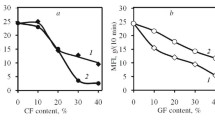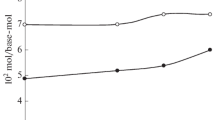The influence of the length and concentration of carbon (CF) and glass (GF) fibers on the rheological, physicomechanical and thermal properties of high-temperature polyphenylene sulfone thermoplastic with a filler content up to 40% (by mass) was investigated. Carbon and glass fibers 0.2- and 3-mm long were used as fillers. The introduction of CF and GF leads to a noticeable decrease in the melt flow index and the impact strength of polyphenylene sulfone, while the yield stress disappears on the stress-strain diagram, which is caused by a decrease in the material’s ability to plastic deformations. With an increase in the fiber content, the elastic modulus and tensile strength of the composite increase both in bending and in tension. A significant increase in heat resistance occurs with an increase in the CF content, and samples with a CF content of 0.2 mm have a higher mass loss temperature. In the case of composites with GF, there are no significant changes in heat resistance.






Similar content being viewed by others
References
G. N. Petrova and E. Ya. Beider, Trudy VIAM, 48, No. 12, 65-73 (2016).
Yu. A. Mikhailin, Heat-Resistant Polymers and Polymeric Materials [in Russian], Professiya, St. Petersburg (2006) 624 p.
K. T. Shakhmurzova, A. A. Zhansitov, et al., Izv. KBSU, 6, No. 3, 64-69 (2016).
A. A. Zhansitov, S. Yu. Khashirova, et al., High Perform. Polym., 29, No. 6, 724-729 (2017).
Functional Fillers for Plastics [English to Russian translation], Ed. M. Xanthos, translation editor V. N. Kuleznev, Nauchnye Osnovy i Tekhnologii, St.-Petersburg (2010) 462 p.
Polymer Blends, V. II: Functional Properties [Russian to English translation], Eds. D. R. Paul and C. B. Bucknall, translation editor V. N. Kuleznev, Nauchnye Osnovy i Tekhnologii, St. Petersburg (2009) 606 p.
M. L. Kerber, V. M. Vinogradova, et al., Polymeric Composite Materials: Structure, Properties, Technology [in Russian], textbook, ed. A. A. Berlin, Professiya, St. Petersburg (2008) 560 p.
The work was performed with the financial support of the Ministry of Education and Science of the Russian Federation under contract 14.577.21.0278 dated September 26, 2017. Project identifier: RFMEFI57717X0278.
Author information
Authors and Affiliations
Corresponding author
Additional information
Translated from Khimicheskie Volokna, No. 4, pp. 98 – 102, July – August 2018.
Rights and permissions
About this article
Cite this article
Slonov, A.L., Zhansitov, A.A., Rzhevskaya, E.V. et al. Influence of the Length and Concentration of Carbon and Glass Fibers on the Properties of Polyphenylene Sulfone. Fibre Chem 50, 354–360 (2018). https://doi.org/10.1007/s10692-019-09989-0
Published:
Issue Date:
DOI: https://doi.org/10.1007/s10692-019-09989-0




